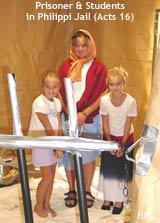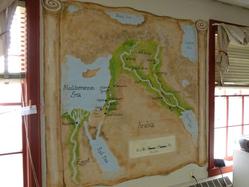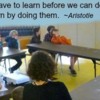
An article for Rotation.org by Neil MacQueen.
This article will make more sense if you know what the Workshop Rotation Model is.
We're now up to ten "Dirty Little Secrets! "
(Dirty Secrets!? You know, something kept hidden; something shared only confidentially with a few...)
The Rotation Model's "Dirty Little Secrets"
The Workshop Rotation Model was originally created in response to a set of problems that most Sunday Schools experience. Thus, even if you don't use the Rotation Model, you have undoubtedly experienced many of the same problems described below and in this article, and may find some of our insights and solutions helpful.
While some look at Rotation as a creative way to do Sunday School (and it is), when we came up with the Rotation model, creativity was already part of our Sunday School DNA. Instead, we were looking for PRACTICAL SOLUTIONS to GIVEN PROBLEMS.
For example, we knew our volunteers were, ...volunteers! And maybe not always the best trained or prepared. The Rotation Model CONFESSES THAT as a given.
 I have often called these confessions annd workarounds, "Rotation's Dirty Little Secrets," because they confess something about our folks that we don't often say out loud. More importantly, we needed a Model that didn't let these problems hold back our program.
I have often called these confessions annd workarounds, "Rotation's Dirty Little Secrets," because they confess something about our folks that we don't often say out loud. More importantly, we needed a Model that didn't let these problems hold back our program.
So...yes, yes, yes, "Rotating to different workshops is creative and great for the kids,"
-- but one of the main reasons we rotate is quite simply this:
The average volunteer won't teach a new lesson
that well the first time.
That is Rotation's "Dirty Little Secret" #1
Well-meaning and even great teachers don't always get it right on the first try. This should come as no surprise. We all need to practice new things to get better at them. We all know how to do an art project better after we've done it once. But in the traditional Sunday school model, teachers never get the chance to practice or do-over because the lesson changes every week. Each week is a brand new "dry run." (Read more about the benefits of this "do-over.")
The Rotation Model solves this problem by having the teachers repeat their lesson for several weeks in a row, to different groups. In Rotation, we're simply recognizing that the first week is a dry-run, and the 2nd week, repeating the lesson to a new group will be a lot better.
Remember how important teacher training used to be? In effect, the Rotation Model creates in-class, on-the-job training.
Doesn't matter who you are or how much experience you have, repetition is as important to our teachers as it is to our students. The Rotation Model admits this, and embraces it.
- To the average volunteer, repetition is a godsend, especially to those with poor preparation skills.
- To good teachers, repetition allows them to hone their approach, and really get creative.
Application: Even in a small church, ideally you want to have a minimum of two groups rotating. This let's you take advantage of the "do better next week" effect. Also makes life easier on the teacher.
To leaders and lesson writers, repeating lessons means your hard work and great ideas are no longer captive to bad preparation. It means your teachers can tweak your great ideas to make them more workable, and add their own insights/tweaks as well. In the old model, they were always back at square one each week.
Most of our volunteer teachers want to succeed. The Rotation Model gives them that chance. And teachers who feel fulfilled are usually happy to say "yes" the next time around.
Dirty Secret #2: We Rotate to compensate for lack of preparation
In spite of best intentions and training, the average volunteer will never prepare as much as we want them to. If you don't agree with this statement, you probably haven't been involved with Sunday School very long! And in spite of our best preparation, every teacher knows how to better prepare "the next time" -- if we give them a chance to do the lesson again.
When the traditional model changes the lesson every week, it leaves us in a perpetual state of "less-prepared-than-we-want." Rather than badger volunteers, or set them up to feel guilty and inadequate, Rotation allows them a DO-OVER. If they blow the lesson the first week for whatever reason, they have all next week to re-think and prepare to do-over with the next class.
Quite frankly, knowing what we know about our volunteers (and ourselves), it's amazing that anyone thought the traditional new-lesson-per-week model was the right approach for most of our volunteers. Great idea if you're selling curriculum, though. ![]()
Dirty Secret #3: We Rotate to "cover" for some of our teachers.
We rotate our kids to different teachers because some of our wonderful volunteers are simply not that good.
Yes, I wish this were UNtrue, but I'm a realist. EVERY church has volunteers who for whatever reason, just aren't good some of the time, or most of the time, but they want to help. You know who I'm talking about.
The problem with the old model is that we sentenced entire grades to those mediocre teachers for an entire year. Do 4th graders who spend an entire year with Mr. Boring and Miss Perpetually Unprepared return to become excited 5th graders? Not so much. ![]()
The Rotation Model reduces the inevitable exposure of our kids to sub-par volunteers. And by assigning those volunteers to easy and exciting workshops, or a workshop more suited to their skills and limitations, we MINIMIZE what they lack, and MAXIMIZE what they're good at.
The corollary to this is that some workshops are easier to teach than others, and those are good workshops to slot-in certain teachers.
Dirty Secret #4: Rotating Let's Staff and Leaders Regain Control of the Program
If you've been around the church long enough, you've experienced certain teachers who have a death-grip on a particular grade or room. Sometimes they are good teachers, but often they are simply arrogant, believing their way is the best, ...often to the detriment of the kids. They say things like, "My class doesn't need media." "Our kids need serious Bible study." "This curriculum is never good enough." (And you see them in there doing 15 minutes of lecture followed by crayons and glue, and then a game unrelated to the lesson.)
I've met teacher's like this who acted like they owned the room, were resistant to change, and were unaccountable to the leadership. Interestingly, some of them actually WERE good teachers in some ways, but they tended to be stuck in their ways, and were impervious to direction.
The Rotation Model puts workshop assignments and activities back in the hands of the leaders. It also creates a calendar of workshop "slots" you can use to bring in new blood. It's a great way to move out or limit the impact of certain teachers and discover better ones. (I know that sounds callous, but our kids should not have to suffer for our unwillingness to tell the truth in love.)
The kids get exposed to a wider variety of caring adults, each with their own talents. And I've met quite a few "old Sunday School warhorses" who actually prefer Rotation once they try it.
Oh...and catch this: many of "those old-school teachers" LIKE having the opportunity to focus in a workshop better suited to their style. "Mr Smith who never met an art project he liked," never has to teach in the Art Workshop. But you know, he was great when it came to games, and he now does all our Bible Games workshops.
Dirty Secret #5: We Rotate because Creative Lesson Prep is NOT that Easy.
Few volunteers have the time and resources to pull off a new creative lesson every week when you are changing the story on them every week.
Under the old model, Sunday morning could resemble a mad scramble for props, game pieces, art supplies, videos, markers, script copies, Bible pictures, and every other thing you WISH you had more time to assemble. And the more creative you are, the bigger the burden.
Because Rotation slows down the rate of change and preparation you only have to do the mad-scramble for Week 1 of the rotation, and then re-use and improve in successive weeks as you repeat the lesson. (This is why we often say that Week 1 of Rotation is a "dry run" that prepares you for subsequent weeks. Whereas, in the traditional model, EVERY week is a dry-run.)
Not only is repeating the lesson helpful, but having WORKSHOPS is extremely helpful as well. The Art Workshops is always full of art supplies, the Video Workshop already has the equipment and popcorn ready. The Drama Workshop is already set-up with staging, props and costumes. And once you set it up for the Last Supper Drama or art project or video, it can STAY THAT WAY for your four or five week rotation.
In the traditional model, you have to reset the room every week to accommodate a new lesson.
From the kids' perspective, they get super-creative and memorable lessons EACH week in really fun rooms.
(Dirty Secret 5-Remix: We Rotate So We Don't Have to Tear It Down Every Week)
This bears repeating again: Nobody in their right mind would convert their entire classroom into Paul's Philippi Prison for just one week. But in Rotation, you will do it for for four weeks
 In Rotation you can actually JUSTIFY bringing a real row-boat into your Drama Workshop for Peter and Jesus Walk on Water, or making it out of refrigerator box.
In Rotation you can actually JUSTIFY bringing a real row-boat into your Drama Workshop for Peter and Jesus Walk on Water, or making it out of refrigerator box. In the traditional model, you'd make it out of cushions or chairs.
In Rotation, you can have really comfy furniture to watch your videos in.
In the traditional model, your multi-purpose room has you sitting in folding chairs every week.
Rotation allows us the freedom to imagine, create, and take a breather.
Dirty Secret #6: We Rotate to Force Ourselves and Our Teachers to Use Different Teaching Methods
One of the reasons that made me think up the Rotation Model in the first place was our teachers' failure to use our audio-visual equipment. It sat in the closet every Sunday. They were also failing to use the music cassettes we bought for them. --And skits with costumes? forgeddaboutit
(But, O Lord, how they loved construction paper and worksheets!)
Part of the problem was that the traditional printed curriculum was like a safety blanket to some. Another part of the problem is that the published curriculum assumed the teacher might not have all sorts of supplies and equipment. But at least in our church the biggest truth was that most of our volunteers simply didn't take the time to look at the extra resources we had.
The Rotation Solution: Instead of trying to "supplement" our traditional boring curriculum with videos, in Rotation we create an audio-visual workshop where the lesson CENTERS on that medium and the room always has the equipment ready to be used. There is no other lesson activity or unrelated materials in that room. It's all about the video.
We create an Art Workshop that is taught with real art materials by teachers who like art, and filled the room with all our art supplies, rather than hiding them in cabinets around the building.
We created a music workshop and staffed it with teachers who LIKED to teach with music, (such a concept).
If the teacher doesn't like using video or real art, or computers, or skits, they simply aren't recruited to teach that kind of workshop.
Dirty Secret #7: We Rotate Into "Workshops" to regain the Learning Space and Give Us Time and a Great Excuse to Assemble Creative Decor!
In the traditional model, most Sunday School classrooms are sterile and multi-purpose. Each classroom looks pretty much like the next. And though every year we encouraged teachers to decorate, most rarely did more than hang a few posters and add a new coat of construction paper on the bulletin board. We expected the teachers to decorate, to make their rooms invited, and too often the results were underwhelming.
By making the classrooms "their room for the year" the creative leaders were left merely with the power of suggestion.
Rotation puts creative people in control of EACH classroom's design, i.e., the "workshop." The teachers come into a creative space already set up for their lessons. They only have to make sure the supplies for their lesson are out and ready.
And because Rotation slows down the rate of story change, ...focusing on a single story for four or five weeks in a row, the workshop design and teacher can dress up the workshop space to match the STORY.
The kids get learning environments they can't wait to get into, and the teacher gets a workshop where all the creative materials are at hand, not out-of-sight in a closet.
Dirty Secret #8: We Rotate so that we can experiment with creative ideas.
A Paul's Journey rotation can now have a "Philippi Prison" room, or a "Map" workshop. A music workshop can be converted to a computer lab for part of the year. Your Pentecost lessons can have a sailboat and movement workshop.

The traditional model clogged our classrooms with tables and chairs. It required leaders to ask teachers for permission to change the space and schedule. Rotation Model brings flexibility to your space and planning. It puts leaders and creativity back at the center of the program, rather than on the periphery.
Dirty Secret #9: We Rotate because not all our kids are there every Sunday.
In many churches, attendance is off to the point where the average kid is only there every other week. If you're changing the lesson each week, that means your kids are missing half your lessons. This also means that half your curriculum budget is being wasted on kids who aren't there.
By slowing down the rate of story change, Rotation makes SURE our irregular attenders are getting exposed to the MAJOR stories of the Bible, while deepening their knowledge in our regular attenders. Traditional curriculum's 52 new stories a year reflects a by-gone era. And quite frankly, it didn't produce Bible literacy or attendance anyway. Just ask the parents who used to sit in those classes, -if you can find them.
Rotation is a Win-Win for regular and irregular attenders.
Dirty Secret #10: Rotation Model Can Fail Because People Can Fail
Most Rotation fans can't imagine why anyone would want to go back to the way things were. Yet there are some churches that do just that. They "try Rotation" for a few years, and end up going back to graded curriculum. That's the "dirty little secret" about churches.
Why do they fail and revert? Several reasons:
1. New leaders get hired who only see the workload, instead of the reasons behind the change. Or they have no investment in what the last person created and want to put their own stamp of the program.
2. Some teachers like control, and like being the professorial center of attention. Traditional curriculum is a feast of teacher-centered blah-blah-blah.
3. The traditional model is something people still remember, and so it's easy to adopt.
4. Churches with declining attendance or shifting demographics have high hopes that "the next new & improved curriculum" will solve their problems.
5. The curriculum publishing industry is always coming up with something shiny and new.
See my full article about "How the Rotation Model Can Fail."
I'm sure there are other good models. I'm also sure that the traditional one isn't one of them! Whatever model you choose, it must be able to overcome the realities of teaching with volunteers in today's Church, and the importance of repetition and creativity in learning. If it doesn't, if it doesn't confess and try to workaround our "dirty little secrets," then it too will fail.
<>< Neil
Neil MacQueen is a Presbyterian minister specializing in Christian education. He is co-author of the book, "Workshop Rotation: A New Model for Sunday School" (Geneva). Neil is one of the founders of Rotation.org. This article may be copied and used for teaching purposes provided its source is cited.
Photo copyright info:
Quiet, by Brian Tomlinson is licensed under CC BY 2.0
Other photos from Rotation churches; used with permission.
Printed from https://www.rotation.org






